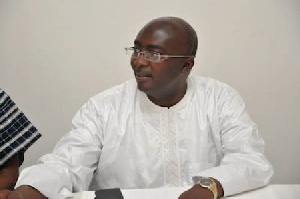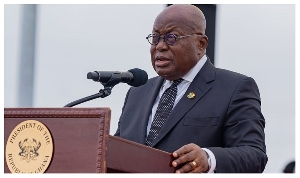- Home - News
- TWI News | TV
- Polls
- Year In Review
- News Archive
- Crime & Punishment
- Politics
- Regional
- Editorial
- Health
- Ghanaians Abroad
- Tabloid
- Africa
- Religion
- Election 2020
- Coronavirus
- News Videos | TV
- Photo Archives
- News Headlines
- Press Release
General News of Wednesday, 25 March 2015
Source: starrfmonline.com
50% of Bawumia's lecture was for political advantage – Economist
Economist Dr John Gatsi has told Morning Starr’s Kafui Dey on Starr 103.5FM that Tuesday’s lecture by Dr Mahamudu Bawumia on the $940-million bailout from the International Monetary Fund (IMF) was fraught with politics.
“…The only area that I think will be interesting talking about is the way he placed his interpretation on the issue but I do understand that because now he is an active politician seeking to come to power, so about 50 percent of the interpretation could be captured in political advantage…
“You’ll realise that the beginning of the lecture, he tried to compare the NPP administration to the current administration. When it came to the amount of revenue raked in under the NPP and NDC, he tried to put a distinction between the period between 2001 and 2008; and 2009 and 2014, but when it came to expenditure, you realise that he focused only on the expenditure side between 2009 and 2014.
“One would have done that and provided conditions prevailing in those days [as] regards the level of expenditure at that time and the level of expenditure now. That was not done. That is the nature of the presentation. When he wants to use the data to project his period, he is silent but when he wants to say adverse effects about the current government, you’ll see that he will be dwelling only on 2009 to 2014 and that itself is very disturbing,” Dr Gatsi observed.
At his lecture on Tuesday, the Running Mate to Nana Akufo-Addo said the Mahama-led administration has borrowed about Ghc66.6 billion in the last six years, despite proceeds from gold and cocoa shooting up significantly within the same period while the government also had access to oil revenue, an advantage no government ever had.
“It should be noted that the fiscal deficits as a percentage of GDP in the last three years (at 9.5%, 10.9% and 12% of GDP) have exceeded the 8.6% deficit in 2000 that sent the economy into a tailspin,” he said.
The former Deputy Governor of the Bank of Ghana said at the lecture which was on the topic: “The IMF Bailout, Will the Anchor Hold” at the Central University College that: “Probably the most significant contributor to Ghana’s current economic malaise is the ballooning and unsustainable public debt less than a decade after being granted HIPC debt relief to the tune of $4.2 billion.
“The debt relief obtained under HIPC and the accompanying fiscal policy stance resulted in a significant reduction of the debt burden. By the end of 2008, Ghana’s total public debt stood at Ghc9.5 billion (33% of GDP). In the last six years, however, the stock of public debt has seen a dramatic increase to Ghc76.1 billion (67.1% of GDP) at the end of 2014. This is an increase in the stock of debt by 700% (Ghc66.6billion) over a six-year period and it represents an average increase in the stock of debt by 116% a year.
“The interest burden of this high public debt stock has proven to be extremely high. In 2015, interest payments alone on the debt would amount to Ghc9.57 billion. Interest payments have increased from Ghc679 million in 2008 to a projected Ghc9.57billion in 2015 (an increase of 14 fold). Ghana’s total debt in 2008 was Ghc9.5 billion, but interest payments in 2015 alone would amount to Ghc9.5 billion,” he added.
Dr. Bawumia explained that these high interest payments occasioned by the astronomic accumulation of debt within the last six years means that money which could have been spent on critical areas were sunk into servicing the debts.
“The picture becomes clearer when one compares the amount spent on interest payments to allocations to various Ministries as spelt out in the 2015 Budget.
“The total sum allocated to these 8 key ministries - Education; Food & Agriculture, Water Resources, Works & Housing; Transport; Roads & Highways; Trade & Industry; Fisheries; and Health - from the budget…amounted to Ghc952 million. Interest payment on Ghana’s public debt stock in 2015 would amount Ghc9.5 billion, i.e. 10 times the combined allocation of these eight critical ministries. This situation is, in fact, reminiscent of Ghana in the run up to HIPC where the debt burden had taken away critical resources that could have enhanced capital and social expenditure,” he said.
The former Deputy Governor of the Bank of Ghana also said the loose monetary policy of the Bank of Ghana is one of the factors that had led the economy into the abyss.
“There has been a dramatic increase in central bank financing of government recently (i.e. equivalent to the printing of money), in addition to borrowing to finance the fiscal deficit.
“Central bank financing (net claims on government) has increased from Ghc1.45 billion in 2008 to Ghc13.95 billion by 2014, an 863% increase.
“The excess printing of money to finance the fiscal deficit causes inflation. In accommodating Government in this manner, the Bank of Ghana is by itself undermining the value of the currency that it is required by law to protect,” he said.
Dr. Bawumia cited the declining growth of the Ghanaian economy, as another factor underlining the crisis the economy finds itself in.
“The 2015 budget shows an economy in decline. Real GDP growth has declined from 15% in 2011 (with the onset of oil production to a projected 3.5% in 2015 (including oil). The decline in economic growth is reflected across all sectors (Agriculture, Industry and Services).
“The 2015 budget is projecting non-oil growth of 2.7% in 2015. These facts are as revealing as they are disturbing. The growth rate in 2015 would be just about what it was in the year 2000 and half the rate of the 8.4% achieved in 2008 without oil! Non-oil growth in 2015 will be below the growth rates attained in 2000.”











